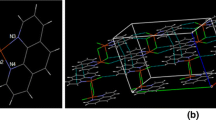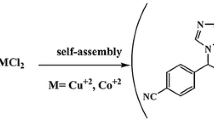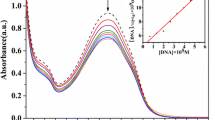Abstract
Ternary Cu(II) complexes [Cu(II)(L)(bpy)Cl] 1, [Cu(II)(L)(Phen)Cl] 2 [L = 2,3–dimethyl-1-phenyl-4(2 hydroxy-5-methyl benzylideneamino)-pyrazol-5-one, bpy = 2,2′ bipyridine, phen =1,10 phenanthroline) were synthesized and characterized by elemental analyses, UV-Visible, FT-IR, ESR, Mass, thermogravimetric and SEM EDAX techniques. The complexes exhibit octahedral geometry. The interaction of the Cu(II) with cailf thymus DNA (CT-DNA) was explored by using absorption and fluorescence spectroscopic methods. The results revealed that the complexes have an affinity constant for DNA in the order of 104 M−1 and mode of interaction is intercalative mode. The DNA cleavage study showed that the complexes cleaved DNA without any external agent. The interaction of Cu(II) complexes with bovine serum albumin (BSA) was also studied using absorption and fluorescence techniques. The cytotoxic activity of the Cu(II) complexes was probed in HeLa (human breast adenocarcinoma cell line), B16F10 (Murine melanoma cell line) and HEPA1–6 celllines, complex 1 has good cytotoxic activity which is comparable with the doxarubicin drug, with IC50 values ranging from 3 to 12.6 μM. A further molecular docking technique was employed to understand the binding of the complexes towards the molecular target DNA. Investigation of the antioxidative properties showed that the metal complexes have significant radical scavenging activity potency against DPPH radical.














Similar content being viewed by others
References
Raman N, Johnson Raja S, Sakthivel A (2009) A transition metal complexes with Schiff-base ligands: 4aminoantipyrine based derivatives–a review. J Coord Chem 62:691
Islam MS, Farooque A, Bodruddoza MAK (2000) Thiocyanato complexes of copper(II), palladium (II), titanium (III) and vanadium (IV) ions containing atridentate Schiff Base ligand. Orient J Chem 16:257
Turan-Zitouni M, Sivaci Kilic FS, Erol K (2001) Synthesis of some triazolyl-antipyrine derivatives and investigation of analgesic activity. Eur J Med Chem 36:685
Casas JS, García-Tasende MS, Sánchez A, Sordo J, Touceda (2007) ACoordination modes of 5-pyrazolones: a solid-state overview. Coord Chem Rev 251:1561
Kurdekar GS, Sathisha MP, Srinivasa B, Naveen VK, Vidyanand KR, Suresh DK (2012) 4 -aminoantipyrine –based Schiff base transition metal complexes as potent anticonvulsant agents. Med Chem Res 21(9):2273–2279
Shoaib M, Rahman G, Shah SWA, Umar MN (2015) Synthesis of 4-aminoantipyrine derived Schiff bases and their evaluation for antibacterial, cytotoxic and free radical scavenging activity. Bangladesh J Pharmacol 10(2):332–336
Joseph J, Rani AB (2014) Antioxidant and biochemical activities of mixed ligand complexes. Appl Biochem Biotechnol 172:867–890
Ouyang X-M, Fei B-L, Okamura T-a, Sun W-Y, Tang W-X, Ueyama N (2002) Synthesis, crystal structure and superoxide dismutase (SOD) activity of novel seven-coordinated manganese(II) complex with Multidentate di-Schiff Base ligands. Chem Lett 3:362–363
Datta A, Karan NK, Mitra S, Rosair G (2002) Synthesis and structural characterization of [Cu(NH2CH2C6H4N = CHC5H5N)Cl2]. Naturforsch 57:999–1002
Sharghi H, Nasseri MA (2003) Schiff-Base metal(II) complexes as new catalysts in the efficient, mild and Regioselective conversion of 1,2-Epoxyethanes to 2-Hydroxyethyl Thiocyanates with ammonium Thiocyanate. Bull Chem Soc Jpn 76:137–142
Joseph J, Nagashri K, Boomadevi Janaki G (2012) Novel metal based anti-tuberculosis agent: synthesis, characterization, catalytic and pharmacological activities of copper complexes. Eur J Med Chem 49:151–163
Flarakos J, Morand KL, Vouros P (2005) High-throughput solution-based medicinal library screening against human serum albumin. Anal Chem 77:1345–1353
Neng Zhou, Yi-Zeng Liang, Ping Wang (2008) Characterization of the interaction between furosemide and bovine serum albumin. 872:190–196
Ghosh KS, Sen S, Sahoo BK, Dasgupta S (2009) A spectroscopic investigation into the interactions of 3′-O-carboxy esters of thymidine with bovine serum albumin. Biopolymers 91(9):737–744
Reichmann ME, Rice SA, Thomas CA, Doty P (1954) A further examination of the molecular weight and size of desoxypentose nucleic acid. J Am Chem Soc 76(11):3047–3053
Song YM, Wu Q, Yang PJ, Luan NN, Wang LF, Liu YM (2006) DNA binding and cleavage activity of Ni(II) complex with all-trans retinoic acid. J Inorg Biochem 100(10):1685–1691
Baguley BC, Bret ML (1984) Quenching of DNA-ethidium fluorescence by amsacrine and other antitumor agents: a possible electron-transfer effect. Biochemistry 23:937–943
Kelly JM, Mc Cintoonnell DJ, Oh Uigin C, Tossi AB, Kirsch-DeMesmaeker A, Masschelein A, Nasielski J (1987) Rutheniumpolypyridyl complexes; their interaction with DNA and their role assenstisers for its photocleavage. J Chem Soc Chem Commun 24:1821–1823
Tan CP, Liu J, Chen LM, Shi S, Ji LN (2008) Synthesis, structural characteristics, DNA binding properties and cytotoxicity studies of a series of Ru(III) complexes. J Inorg Biochem 102:1644–1653
Searle MS, Maynard AJ, Williams HE (2003) DNA recognition by the anthracycline antibiotic respinomycin D: NMR structure of the intercalation complex with d(AGACGTCT)2. Org Biomol Chem 1(1):60–66
Sanner MF, Python (1999) A programming language for software integration and development. J Mol Graph Mod 17:57–61
Michel F, Sanner P (1999) A programming language for software integration and development. J Mol Graph Mod 17:57–61
Lakowicz JR (1999) Principles of fluorescence spectroscopy, 2nd edn. Plenum Press, New York
Braca A, Tommasi ND, Bari LD, Pizza C, Politi M, Morelli I (2001) Antioxidant principles from bauhinia tarapotensis. J Nat Prod 64(7):892–895
Saha MR, Hasan SMR, Akter R, Hossain MM, Alamb MS, Alam MA, Mazumder MEH (2008) In vitro free radical scavenging activity of methanol extract of the leaves of Mimusops elengi Linn. Bangladesh J Vet Med 6:197
Nikolav A V, Myachina, LI, Logvinenko VA, (1969) Thermal Analysis, vol 2. Academic Press, New York, p 779
Mohamed GG, Abd EI, Wahweb ZH (2003) Salisaldehyde-2-aminobenzimidazole schiff base complexes of Fe(III), Co(II), Ni(II), Cu(II), Zn(II) and Cd(II). J Therm Anal 73:347
Soliman AA, Mohamed GG (2004) Study of the ternary complexes of copper with salicylidene-2-aminothiophenol and some amino acids in the solid state. Thermochim Acta 421:151
Waheb ZH, Mashaly MM, Fahem AA (2005) Synthesis and characterizationof cobalt(II), cerium(III), anddioxouranium(VI) complexes of 2,3-dimethyl-1-phenyl-4-salicylidene-3-pyrazolin-5-one mixed ligand complexes, pyrolytic products, and biological activities. Chem Pap 59(1):25
Radmakrishnan T, Joseph PT, Prabhakaran CP (1976) Copper(II) complexes of salicylal-4-amino antipyrine and 2-hydroxy naphthal-4-amino antipyrine. J Inorg Nucl Chem 38:2217
Shankar G, Premkumar RR, Ramalingam SK (1986) 4-aminoantipyrine schiff-base complexes of lanthanide and uranyl ions. Polyhedron 5:991
Ramesh R, Suganthy PK, Natarajan K (1996) Synthesis, spectra and electrochemistry of Ru(III) complexes with Tetradentate Schiff bases. Synth React Inorg Met – Org Chem 26:47
Lindoy L, Moody WE, Taylor D (1977) Mass spectral and nuclear magnetic resonance (proton and carbon-13) study of metal complexes of quadridentate ligands derived from 1,2-diaminoethane and substituted. Beta.-diketones; x-ray structure of N,N′-ethylenebis(5,5-dimethyl-4-oxohexan-2-iminato)nickel(II). Inorg Chem 16:1962
Alemi AA, Shaabani B (2000) Synthesis and characterization of aSchiff base of P-tert butylcalix[4]arene and its complex withcopper(II). Acta Chim Slov 47:363–369
Chang CJ, Connick WB, Low DW, Day MW, Gray HB (1998) Electronic structures of nitridomanganese(V) complexes. Inorg Chem 37:3107–3110
Mashalay MM (1996) Synthesis and physico-chemical studies on rhenium(V) complexes with 2- benzimidazolethione. Synth React Inorg Met-Org Chem 26:211–224
Mashalay MM (2002) Preparation and thermal studies of some new oxorhenium(V) complexes with 2-amino-5-methyl-1,3,4-thiadiazole. Synth React Inorg Met-Org Chem 32:373–397
Raman N, Kulandaisamy A, Jeyasubramanian K (2001) Synthesis, spectroscopic characterization, redox and biological screening studiesof some Schiff base transition metal(II) complexes derived fromsalicylidene-4aminoantipyrine and 2-aminophenol/2-aminothiophenol. Synth React Inorg Met Org Chem 31(7):1249–1270
Nakamoto K (1997) Infrared and Raman. Spectra of inorganic and coordination compounds 3rd edition. Wiley Inter- Science, New York
Ashwin KK, Laxma Reddy K, Satyanaryana S (2011) Synthesis, DNA binding, DNA photocleavage and antimicrobial activity of [Co(bpy)2DMHBT]3+, [Co(dmb)2DMHBT]3+ and [Co(phen)2DMHBT]3 + Complexes. Spectrosc Lett 44(1):27–37
Raman N, Kulaindaswamy A, Jeyasubramanian K (2002) Synthesis, spectral, redox, and antimicrobial activity of schiff base transition metal(ii) complexes derived from 4-aminoantipyrine and benzyl. Synth React Inorg Met Org Nano Met Chem 32:1583–1610
Salman M, Saadesh M (2013) Synthesis, characterization and biological properties of Co(II), Ni(II), Cu(II) and Zn(II) complexes with an SNO functionalized ligand. Arab J Chem 6:191–196
Rabindra Reddy P, Shilpa A (2011) Oxidative and hydrolytic DNA cleavage by Cu(II) complexes of salicylidene tyrosine schiffbase and 1,10 phenanthroline/bipyridine. Polyhedron 30:565–572
Choi SN, Menzel ER, Wasson JR (1977) Electronic spectra of copper(II) dithiocarbamates. J Inorg Nucl Chem 39:417–422
Kumar DN, Singh BK, Garg BS, Singh PK (2003) Spectral studies on copper(II) complexes of biologically active glutathione. Spec Chim Acta A 59:1487–1496
Mariappan M, Maiya BG (2005) Effects of Anthracene and Pyrene units on the interactions of novel Polypyridylruthenium(II) mixed-ligand complexes with DNA. Eur J Inorg Chem 11:2164–2173
Stemp EY, Weiner L, Sagi I, Yellin RA, Shanzer A (2004) Direct photo-induced DNA strand scission by a ruthenium bipyridyl complex. J Inorg Biochem 98:1750–1756
Deshpande MS, Kumbhar AA, Kumbhar AS (2007) Hydrolytic cleavage of DNA by a ruthenium(II) polypyridyl complex. Inorg Chem 46:5450–5452
Kumar CV, Asuncion EH (1993) DNA binding studies and site selective fluorescence sensitization of an anthryl probe. J Am Chem Soc 115:8547–8553
Wolfe A, Shimer GH, Meehan T (1987) Polycyclic aromatic hydrocarbons physically intercalate into duplex regions of denatured DNA. Biochemistry 26:6392–6396
Waring MJ (1965) Complex formation between ethidium bromide and nucleic acids. J Mol Biol 13:269–282
Baguley BC, Bret ML (1984) Quenching of DNA-ethidium fluorescence by amsacrine and other antitumor agents: a possible electron-transfer effect. Biochemistry 23:5937–5943
Lakowicz JR, Webber G (1973) Quenching of fluorescence by oxygen. Probe for structural fluctuations in macromolecules. Biochemistry 12(21):4161–4170
Ji LN, Zou XH, Liu JG (2001) Shape- and enantioselective interaction of Ru(II)/Co(III) polypyridyl complexes with DNA. Coord Chem Rev 216-217:513–537
Liu YJ, Chao H, Tan LF, Yaun XY, Wei W, Ji LN (2005) Interaction of polypyridyl ruthenium (II) complex containing asymmetric ligand with DNA. J Inorg Biochem 99:530–537
Deng H, Xu H, Yang YH, Li H, Zou H, Qu LH, Ji LN (2003) Synthesis, characterization, DNA-binding and cleavage studies of [Ru(bpy)2(actatp)]2+ and [Ru(phen)2(actatp)]2+ (actatp = acenaphthereno[1,2-b]-1,4,8,9-tetraazariphenylence). J Inorg Biochem 97:207–214
Satyanarayana S, Dabowiak JC, Chaires JB (1993) Tris(phenanthroline)ruthenium(II) enantiomer interactions with DNA: mode and specificity of binding. Biochemistry 32(10):2573–2584
Qin DD, Yang Z-Y, Wang BD (2007) Spectra and DNA-binding affinities of copper(II), nickel(II) complexes with a novel glycine Schiff base derived from chromone. Spectrochim Acta A 68:912–917
Surendra Babu MS, Hussain Reddy K, Krishna G (2007) Synthesis characterization DNA interaction and cleavage activityof new mixed ligand copper(II) complexes with heterocyclic bases. Polyhedron 26:572–580
Bi SY, Song DQ, Tian Y, Zhou X, Liu ZY, Zhang HQ (2005) Molecular spectroscopic study on the interaction of tetracyclines with serum albumins, Spectrochim. Acta Part A 61:629–636
Raja DS, Bhuvanesh NS, Natarajan K (2012) Structure-activity relationship study of copper(II) complexes with 2-oxo-1,2-dihydroquinoline-3-carbaldehyde (4'-methylbenzoyl) hydrazone: synthesis, structures, DNA and protein interaction studies, antioxidative and cytotoxic activity. J Biol Inorg Chem 17:223–227
Iyyam Pillai S, Vijayaraghavan K, Subramanian S (2014) Evaluation of DNA-binding cleavage BSA interaction of Zn-hydroxy flavone complex. Der. Pharma Chemica 6:379–389
Nicholson JP, Wolmarans MR, Park GR (2000) The role of albumin in critical illness. British J Anesth 85:599–610
Hu Y, Liu Y, Wang J, Xiao X, Qu S (2004) Study of the interaction between monoammonium glycyrrhizinate and bovine serum albumin. J Pharm Biomed Anal 36:915–919
Bhuiyan MAR, Hoque MZ, Hossain SJ (2009) Free radical scavenging activities of Zizyphus mauritiana. World J Agr Sci 5(3):318–322
Ferrari M, Fornasiero MC, Isetta AM (1990) MTT colorimetric assay for testing macrophage cytotoxic activity in vitro. J Immunol Methods 131:165–172
Rey NA, Neves A, Silva PP (2009) A synthetic dinuclear copper (II) hydrolase and its potential as antitumoral: cytotoxicity, cellular uptake and DNA cleavage. J Inorg Biochem 103:1323–1330
Rabindra Reddy P, Chandrashekar R, Satyanarayana B (2015) New Bio-Based Cu(II) Complexes and Study their Anti-Cancer Activities. doi:10.1007/s10895-016-1801-8.JOFL-D-15-00487.1
Gao E, Sun Y, Liu Q, Duan L (2006) An anticancer metallobenzylmalonate: crystal structure and anticancer activity of a palladium complex of 2,2′-bipyridine and benzylmalonate. J Coord Chem 59:1295–1300
Acknowledgements
One of the authors Dr. B. Anupama, Assistant Professor, Department of Chemistry, RBVRR Women’s College is thankful to the University Grants Commision (No. F:MRP-5429/14(SERO/UGC) for providing fund to this research study. I also thank to Management of RBVRR Women’s College and Dr. M. Surekha Reddy, Head, Department of Chemistry, RBVRR Women’s College for providing laboratory facilities in the College.
Author information
Authors and Affiliations
Corresponding author
Electronic supplementary material
Fig. S1
1H–NMR Spectrum of Ligand (DOCX 1062 kb)
Fig. S2
ESI Mass spectra of ligand, complexes 1 and 2. (DOCX 815 kb)
Fig. S3
Thermograms of complexes 1and 2 (DOCX 1440 kb)
Fig. S4
Infrared spectra of complexes 1 and 2 (DOCX 141 kb)
Fig. S5
ESR spectra of complexes 1 and 2 (DOCX 87 kb)
Fig. S6
Antioxidant Activity of the complexes (DOCX 21 kb)
Fig. S7
Structures of metal complexes 1 and 2 (DOCX 56 kb)
Rights and permissions
About this article
Cite this article
Anupama, B., Aruna, A., Manga, V. et al. Synthesis, Spectral Characterization, DNA/ Protein Binding, DNA Cleavage, Cytotoxicity, Antioxidative and Molecular Docking Studies of Cu(II)Complexes Containing Schiff Base-bpy/Phen Ligands. J Fluoresc 27, 953–965 (2017). https://doi.org/10.1007/s10895-017-2030-5
Received:
Accepted:
Published:
Issue Date:
DOI: https://doi.org/10.1007/s10895-017-2030-5




